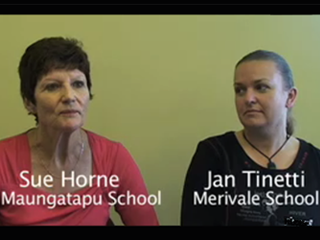

No media file is available.
- Duration:
-
9:21
- Views:
- 6721
Edited transcript
Jan Tinetti from Merivale School and Sue Horne from Maungatapu School have been looking at using both The New Zealand Curriculum and Te Marautanga o Aoteoroa in their schools.
Engaging with parents
For many in our community, they have not had a good experience with school and so therefore school is quite an alien environment to them. We are trying to make school an environment where they can feel at home. We have done this through several different strategies. We have a lunch programme where local mums have formed a trust and make cheap lunches for the children, we get them together and we talk about learning. We go into homes and run home hui, where we supply all the kai, and invite people along. We are getting an idea of where the parents want to go with their child’s learning. We deliberately create activities to involve parents. For example, we decided to update the Kapa Haka uniforms and had parents help design and create those. And at the same time they were getting hit with the learning. What we found is that parents wanted to engage in discussions and are feeling much more comfortable about coming into the school.
Key competencies and the graduate profile
Another issue is where do key competencies sit. We decided to look at the graduate profile in Te Marautanga o Aotearoa, which we call the learner profile, and incorporate the key competencies within the learner profile.
Incorporating tikanga Māori into mainstream teaching
We needed to find time and the right personnel to help staff incorporate tikanga Māori into their mainstream teaching. The Kaiarahi i te reo has been a really important person within our school, being able to work alongside our teachers in the classroom, not doing it for them but strengthening their abilities. In the long run that has made such a positive difference to children’s achievements.
Ka Hikitia
Teachers can connect in with the children’s world in a safe environment. And that, to me, is the whole philosophy behind Ka Hikitia. It is for us to connect into their world, not the other way around. So we are actually strengthening their learning from within their world.
Resourcing
There is a lack of resources to support Te Marautanga o Aotearoa. There is a big difference between what is available for my rumaki staff and mainstream staff.
Perspectives
When we come together to talk about issues, I always have to be mindful that my rumaki staff look at things from a Māori perspective. There are two trains of thought going on within that one room. I make it a point to check in with my rumaki staff afterward to see how it all fits with their understanding, their philosophy.
Communication is the key
At our school, the Rumaki teachers noticed that the children were speaking English in the playground so they looked for contexts to engage the children in speaking te reo outside of the classroom. This year they have developed their own sports programme. Each teacher takes a different sport, you have older children working with young children, and all the instructions are in te reo. The children have to interact in te reo. So it is actually providing a context for them to use their te reo skills outside the classroom. That is exciting.
But in a mainstream school, initially, it was seen as ‘Oh the Rumaki, they’re not doing sports with us, they don’t like what we’re doing’. Even I was a little bit alarmed. I sat down with the teachers and they explained they could use concepts and aspects of tikanga in the sports programme that were important to them. It is in an authentic context, the children are enjoying it, and they are engaged. All we had to do was sit down and have a conversation with the rest of the staff and explain their thinking and the staff said, “what a great idea”.
Communication is important. We need to always be aware that things can be done differently, that doesn’t make it right or wrong, just different. The thinking behind it is always for the children. We have to be aware of that and we have to embrace it.
Giftedness
My rumaki teacher spoke to me about aspects of giftedness within the Māori dimension that is very different from the pakeha concept, which tends to be academically driven. They have aspects that relate to mana, spirituality, to caring for others, those are things they regard as qualities of gifted and talented. How do you cater for that in the school? We can’t run a separate programme for those children but it is important, I believe, to infuse that into the classroom programme.
I was talking about what makes a good leader with one of the parents on the BOT. She said to me, “My son is a good leader and has been identified by his iwi as a leader, do you understand what a leader is in Māori terms?” I had to admit that I didn’t understand. She explained things from the Māori point of view and I also did some research into Māori gifted and talented. It was so different to what my concept of gifted and talented was. We changed our whole philosophy around. It is taking a lot to facilitate that change within our heads. It is an exciting element, looking at things in a completely different way.
Published on: 13 Jul 2009
Return to top

 No media file is available.
No media file is available.
